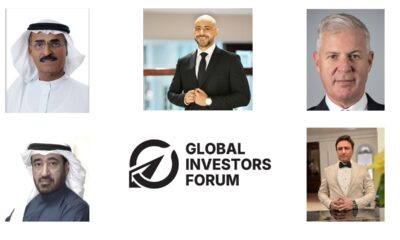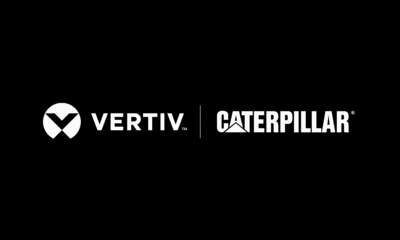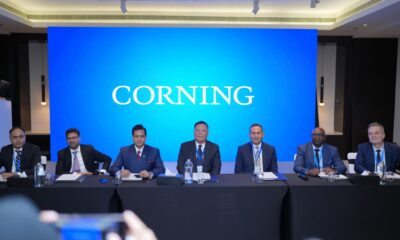Tech Features
Seclore Sets a New Compliance Standard for Navigating Complex Global Regulations with Data-Centric Security

Seclore, the leading provider of data-centric security solutions, sets a new standard for enterprises worldwide by providing enhanced compliance controls and reporting capabilities that give companies an unparalleled ability to meet and exceed current and emerging cybersecurity and data privacy regulations. The Seclore Data-Centric Security Platform embeds privacy controls into the data itself, so each piece of data gets its own layer of security, authentication, visibility, and control. This level of protection and visibility helps organizations keep sensitive information safe and maintains compliance across a growing number of global regulatory frameworks.
In a post digital-transformation world, regulations go beyond privacy and cybersecurity, encompassing everything from operational resilience to export controls and anti-corruption. Coalfire’s Compliance Report 2023 found that 70% of service organizations need to demonstrate compliance with at least six frameworks spanning cybersecurity, data privacy, and other taxonomies. Some regulations will hold organizations liable for data shared with partners and other third-parties, and penalties for noncompliance include personal liability and substantial fines. This shift has made global regulatory compliance more complex, critical, and costly than ever before.
Compliance with Global Standards
Seclore’s platform is designed to help organizations standardize and federate data policies that protect sensitive data for its entire lifecycle and meet the most stringent global, regional, and yet to be known regulations. Here’s how Seclore’s classification-driven protection, enterprise digital rights management (EDRM), and risk insights dashboards can help reduce complexity and cost in the compliance process:
- Cybersecurity: These guidelines are designed to help organizations maintain cybersecurity best practices and reduce risk. Seclore adheres to standards like ISO 27001, NIST, and SOC II. These guidelines focus on operational elements and security control, and also include demanding encryption, access control, and reporting capabilities — and demonstrating compliance can be a major hurdle for many organizations. Seclore’s risk insights dashboard and SIEM integrations give organizations unprecedented visibility into where their sensitive data is, who has access to it, and what actions have been blocked or permitted.
- Data Privacy: These guidelines protect private data, such as personally identifiable information (PII), biometrics, payment card industry (PCI), or other types of information. Recently a massive uptick in the number of privacy regulations has occurred as government entities move to protect the private information of their citizens. Examples include GDPR (General Data Protection Regulation), CCPA (California Consumer Privacy Act), DPDP (Digital Personal Data Protection), PDPL (Personal Data Protection Law), SDAIA (Saudi Data & AI Authority) NIST 800-171, UAE Cabinet Resolution No. 21, and many others. Seclore’s enterprise digital rights management solution helps organizations encrypt and manage access to digital assets containing privacy-related data, so that data can only be accessed by approved users (even if it’s been exfiltrated).
- Operational Resilience: These guidelines protect the operation of key industries, particularly when disruptions could result in serious harm to the health, safety, and economic prospects of affected citizens. These include the European Union’s DORA (Digital Operational Resilience Act), which mandates risk management in financial institutions; NIS2, which enhances cybersecurity across sectors including energy and healthcare; the CHIPS Act, aimed at strengthening semiconductor supply chains in the U.S.; and Oman’s CS&RF (Cybersecurity and Resilience Framework), which strengthens resilience in critical infrastructure sectors like energy and finance.
- Industry-Specific Compliance: These regulations are usually customized for highly regulated industries like financial services, government, manufacturing, and others. Requirements can be onerous, and governing bodies may even provide standardized resources that organizations can leverage to help simplify compliance. Examples include RBI (Reserve Bank of India) guidelines on outsourced financial services, which mandate certain controls for data shared with third parties; HIPAA, which establishes national standards to protect individuals’ health information in the U.S.; CMMC, which is designed to protect sensitive information shared with U.S. government contractors and subcontractors; and other regulations like GLBA and ITAR. Seclore’s data-centric security platform helps organizations standardize security policies for sensitive data to ensure it’s always protected— whether it’s in your network, shared with a third party, or unlawfully obtained.
“At Seclore, we understand the growing pressure on organizations to comply with global regulatory standards while maintaining a high level of operational efficiency,” said Vishal Gupta, CEO and founder at Seclore. “Our data-centric security approach ensures that enterprises can protect sensitive data and meet stringent compliance standards without sacrificing productivity.”
Meanwhile, Seclore honored esteemed partners from the region on October 16 2024, during GITEX 2024, in an award ceremony. It recognized the region’s top-performing partners for their vital contributions to the Seclore business in the fields of strategic integration, high growth and overall performance. During the ceremony, Seclore selected Bahwan IT (Oman) as the Growth Partner of the Year 2024, Diyar United Company as the Strategic Partner of the Year 2024 (GCC), Cylert as the Strategic Partner of the Year 2024 (Egypt), Procom ME as the Strategic Partner of the Year 2024 (Saudi Arabia) and GBM as the Innovation Partner of the Year 2024 (UAE). Furthermore, the award recognized Help AG with the Excellence Initiative Award 2024 (Saudi Arabia), Anazeem Technology Company with the Value-Added Partner Award 2024 and Sirar by stc with the Government Relations Partner Excellence Award 2024. Seclore also identified vital contributions made by various individuals during the ceremony. In line with this, Hamad Alyassi, Key Account Manager of Cybergate, was honored with the Rising Star Award 2024 (UAE). Amani Zeghan, Cybersecurity Sales Manager of DC Technologies (Jordan) was recognized as Channel Rep of the Year 2024 (UAE), while Hesham ALSehaim, Senior Client Manager of Dimension Data (NTT data), was named as the Channel Rep of the Year 2024 (Saudi Arabia).
Data-centric security gives companies an edge when it comes to meeting the global compliance demands of their business on a global scale. Seclore helps organizations standardize and federate security and compliance so adhering to new compliance requirements is an incremental rather than tectonic shift. Seclore’s data-centric security platform lets organizations encrypt and manage access to digital assets so their regulated data is always protected. This ensures continuous protection across environments and gives organizations real-time data telemetry that can be shared with auditors to prove compliance.
Tech Features
HR-led Initiatives to nurture women-led TECH startups

Professor Fiona Robson,
Head of the School of Social Sciences & Edinburgh Business School
HR is no longer just about recruitment and retention – there is a growing trend towards taking a more creative and innovative approach. This can involve looking at talent through different lenses rather than seeing it as a hierarchical talent management process focusing on vertical promotions within the organization.
In an age where HR rightly have a seat at the strategic table for decision making, they have the opportunity to ensure that appropriate levels of funding and expertise are used to develop a forward-looking talent strategy that goes beyond the norm. Artificial intelligence (AI) brings a plethora of opportunities for organisations to be braver in how they identify potential talent. Using AI to identify talent can be a useful starting point but when it comes to areas such as innovation and identifying an entrepreneurial mindset, it may be more difficult to pinpoint the traits which could indicate potential to innovate.
Where HR teams start to consider and plot non-traditional pathways they may be able to recruit and retain employees with diverse skillsets. Taking an entrepreneurial path opens up the talent pool as it isn’t as focused on people looking at the next hierarchical step up within the organisation. This is important as there are usually resource constraints about how many vacancies are available to fill at the highest pay grades in the organisation. These new pathways should provide opportunities for women to shine in different types of projects and recognise the strategic importance of creative thinking and innovation.
Providing testing opportunities
Depending on the level of finance available there are some additional resources that could be provided. Innovation sprints or challenges can be a great way to test out ideas and receive feedback from different groups of stakeholders. They may facilitate prototyping and identify issues that were not previously considered. Internal technology venture labs can also provide a safe environment to test out ideas and proof of concept. Collaborating with Universities who are experienced in running labs and sprints can be very beneficial, they may also have access to funding to support the development of new products and services. However, in order to be truly successful, they need to ensure that there is a sustainable follow up process before the momentum deflates.
Inclusive Procurement and Equitable IP Policies
Organisations can seek to lead the way and exhibit good practice by reviewing their procurement policies where practicable to ensure that they are inclusive. Examples may include having provision for flexible payment terms which would make it easier for those at the beginning of their entrepreneurship journey. Access to specialist support which could help women to set up their businesses in a more timely way could also break down some of the perceived barriers. Often the processes around procurement can be rather cumbersome so the provision of training which shows exactly how to navigate it could be helpful. Forward looking organisations might seek to approve a process whereby women entrepreneurs are given priority with their applications.
For many women, even thinking about intellectual property (IP) and patents can seem overwhelming if they have never had exposure to this world before. The introduction of simplified processes could act as a springboard to attract more women, particularly if the timeline can be expedited so that there is a shorter gap between the initial idea and when it is approved. Having access to real case studies showing how this happens would also be reassuring. In large organisations, the HR team may be able to encourage the legal team to provide some initial advice so that prospective entrepreneurs get a realistic insight into whether their proposal has merit or not.
Commercial Advantage Through Policy
HR can make a name for itself by encouraging innovation through widening participation and breaking down barriers to encourage, support and recognise innovation. For some HR professionals this may be quite a shift for them so they may also require some reskilling and retraining.
It would be good practice for organisations to regularly review their HR policies to ensure that they reflect the changing eco-system and that there are appropriate diversity clauses within the library of policies, procedures and practices. As part of this, ensuring that there is awareness of bias and how this can sneak into processes unconsciously and inadvertently disadvantage women. The establishment of women’s networks would be a proactive approach and could help them at all of the different stages of developing and executing their entrepreneurial ideas.
Providing funding opportunities may be one of the most impactful decisions that an organisation can make. Obviously this would need to have transparent parameters around it but it could be the difference between an idea being turned into practice or not. If the funding allocation is governed by stakeholders with appropriate expertise in different areas i.e. finance, law, governance and people, this would reduce the organisational risk of investing in small new businesses. Where there isn’t a potential conflict of interest, organisations could also make a significant impact by facilitating market entry and opening doors within networks and supply chains.
Tech Features
The Future of Work-Integrated Learning: Embedding HR Tech Practices in Higher Education

Professor Fiona Robson, Head of the School of Social Sciences and Edinburgh Business School, Heriot-Watt University Dubai

Universities have a responsibility to prepare students for their future career in terms of both skills and knowledge. In an increasingly technological world, managers of the future need to understand the capabilities of HR tech as well as being able to use it.
Exposing students to HR tech platforms can help to prepare them for their future career in HR in terms of skills but also understanding what is going on in the HR space – understanding the priorities and why use of technology is growing. Being familiar and comfortable with HR tech might help them to stand out in the graduate marketplace and from an employer’s perspective could help them hit the ground running. Being able to analyse data to inform organisational decisions is critical and HR tech gives them the ability to get good data and then learn how to use it to make appropriate data-driven decisions.
Real play rather than role play is particularly helpful for students as the learning is more meaningful, and they can visualise what would happen in the workplace. Therefore, using software which is being used in real organisations will add great value to their learning experience and what their future role might involve. Where University academics have strong relationships with industry, they may be able to use real data so that the students get a realistic experience and understand the complexity of what organisations have to contend with.
Where the HR tech has the capability to provide commentary based on the student performance in using it, this is a further source of information of formative feedback which helps students with their academic and personal development. Developing students’ confidence in using tech should not be underestimated as if they have the knowledge but are afraid to use it, their impact will be limited. Ideally, organisations are looking for graduates who are comfortable in learning to use new programmes and understand some of the teething troubles that can emerge when introducing new tech.
Involving HR professionals within the classroom adds significant value to students and helps them to understand the diverse nature of working in an HR team. Therefore where learning to use the HR tech platform can be married with having an HR professional to talk them through how it can be used and the impact of using it, this would further strengthen their learning and experience. There can also be benefits for HR professionals, as they can gain perspectives from students that may differ from those they encounter in the workplace—particularly if they are interested in potential generational differences. Sharing their own knowledge and skills and presenting to University students can also be very beneficial to the personal and professional development of the HR professional.
Organisations are ideally looking for graduates who are confident in using technology and open to trying new systems and ideas, and therefore, if they have been exposed to different types of tech, this could give them an advantage. They can also learn about some of the wider things about technology implementation – for example, issues around ethics as well as the data protection and legal implications of having access to sensitive and confidential information.
Opening Doors with Internships
Internship programmes provide great insights into the industry and allow students to see the links between theory and practice. It also enables them to see all of the different internal and external factors which can have an impact on organisations, and this can be very eye-opening for them. Understanding the roles of different stakeholders is usually one of the key learning points from internships.
In the classroom, we can teach students the theory about organisational culture and individual and team dynamics; however, an internship is where they can see what this actually looks like. Being able to observe how different departments collaborate may help them to make sense of some of the topics they have studied as part of their degree programme.
We shouldn’t underestimate the importance of learning to build relationships in the workplace and to recognise and respond to issues like organisational politics. For some students, exposure to an internship can help cement their career aspirations in identifying which areas of business they find most interesting, and for some students they will be attracted to roles that they may previously not have been aware of.
As most businesses now have an international aspect, it is also valuable for interns to learn about the different angles of internationalisation and what this means for people in their day-to-day activities. Typically they may recognise it is common for organisations to have international customers but may not have considered international supply chains and the complexities of having employees in different countries which operate under different jurisdictions. It may also reiterate the importance of developing the cross cultural skills that they are taught by their lecturers.
If students’ internships are successful and they are identified as being potential talent of the future, the organisation may begin a longer-term relationship with them. For example, they may allow them to focus their dissertation within the organisation or offering them a job once they graduate.
Tech Features
How are leaders in the Middle East using AI to solve for supply chain issues

Attributed by Harsh Kumar, Chief Strategy Officer, Shipsy
The Middle East’s logistics sector is undergoing a fundamental change as industry leaders embrace AI to tackle region-specific challenges and build the foundation for autonomous supply chain operations. “In the wake of the fourth industrial revolution, governments and businesses across the Middle East are beginning to realise the shift globally towards AI and advanced technologies. We estimate that the Middle East is expected to accrue 2% of the total global benefits of AI in 2030. This is equivalent to US$320 billion,” highlights a PwC Middle East report.
When it comes to making supply chains autonomous, logistics leaders in the Middle East agree that there are some inherent challenges in the region that hinder growth and that they are working towards addressing the same.
Addressing the Middle East’s Obstacles to Autonomous Supply Chains
Inaccurate addresses remain one of the most critical pain points for Middle Eastern logistics operations, directly impacting productivity, costs, and customer experience. The region’s diverse linguistic landscape and inconsistent address systems have made last-mile delivery particularly challenging.
In the Middle East, inefficient address structure often results in packages and letters being addressed only with a recipient’s name, city, and country, lacking a specific delivery address. Courier services are typically provided with just a name and mobile number, requiring them to investigate and determine the intended delivery location. According to a report by Logistics Middle East, incorrect addresses can potentially impact more than $7.42 billion in eCommerce revenue in the Middle East.
“AI’s success and differentiation from any other technology before it, will depend on its ability to solve region-specific challenges. Unlike banking and financial services sectors, logistics and supply chain operations often deal with fragmented processes and disconnected systems. AI is uniquely positioned to bridge these gaps by harmonizing data, streamlining workflows and enhancing efficiency across the entire value chain all of which have a direct impact on operational productivity.” said Iyad Kamal, ex COO of Aramex.
Incorrect addresses also create another challenge of driver productivity and retention. With retail customer expectations rising and delivery times shortening, logistics providers will need to focus on making it easier for drivers to complete their work, get the right information at the right time to ensure they deliver a better customer experience.
The challenge compounds due to a flawed hypothesis in route optimization which does not take into consideration real-world variables when allocating deliveries creating delays and impacting driver productivity. Another critical problem that needs to be addressed is financial settlements. Validating data for settlements remains a heavily manual and time-intensive process. It will not be incorrect to say that only about 10% of invoices are accurately validated, as the human effort required is significant. This results in a higher risk of inaccuracies in settlement. AI agents can help here by analyzing delivery proofs against trip data and automatically calculate delay fees using GPS timestamps and contractual rates.
How leaders are moving from Guesswork to Data-Driven Precision
Resource allocation has traditionally relied on intuition, resulting in suboptimal vehicle utilization and excessive mileage. Digital Twin technology is changing this paradigm by enabling logistics providers to run scenario analyses and predict the impact of different allocation strategies before implementation.
Real-time incident management has also evolved beyond manual dashboard monitoring. Autonomous monitoring agents now continuously check operations against KPIs, detecting anomalies like delays or harsh braking incidents. When issues arise, these agents assess impact, proactively communicate updated ETAs to customers, and suggest rescheduling options, thereby drastically reducing resolution times.
Aujan Coca-Cola Beverages Company is leveraging Agentic Incident Management, AI-powered dynamic route optimisation and load balancing and Agentic Control Tower to enhance customer experience by ensuring ETA adherence and real-time visibility.
Fair compensation and equitable workload distribution emerged as critical for combating driver attrition, with leaders emphasizing that rewards must be immediate rather than deferred to maintain motivation. Customer-centric execution requires moving beyond basic data matching. AI-enabled semantic matching creates comprehensive customer profiles that preserve delivery preferences across different drivers and addresses, ensuring consistent service quality.
“Verifying every transaction and validating every invoice, continue to be a massive overhead for supply chain leaders even in 2025. Companies that can leverage AI to automate highly human-intensive processes will unlock velocity as an advantage, making it harder for their competition to catch up.” said Soham Chokshi, Co-Founder and CEO of Shipsy, while emphasizing AI’s role in logistics.
The Road Ahead
Logistics leaders in the Middle East envision autonomous, intelligent, and customer-centric supply chains powered by agentic AI that independently solves complex problems. However, the success of these systems hinges on a human-in-the-loop approach. Balancing algorithmic optimization with human expertise, such as local knowledge and driver preferences, is essential to address the region’s unique challenges, like inefficient address systems. By integrating continuous monitoring and predictive intervention, AI can shift operations from reactive to proactive, but human oversight ensures adaptability and accuracy. This synergy between AI capabilities and human insight drives resilient, efficient, and customer-focused logistics networks.
As the region’s logistics sector continues its digital transformation, these AI-driven foundations are positioning Middle Eastern supply chains at the forefront of global innovation in autonomous operations.
-

 Tech News1 year ago
Tech News1 year agoDenodo Bolsters Executive Team by Hiring Christophe Culine as its Chief Revenue Officer
-

 VAR7 months ago
VAR7 months agoMicrosoft Launches New Surface Copilot+ PCs for Business
-

 Tech Interviews2 years ago
Tech Interviews2 years agoNavigating the Cybersecurity Landscape in Hybrid Work Environments
-

 Tech News4 months ago
Tech News4 months agoNothing Launches flagship Nothing Phone (3) and Headphone (1) in theme with the Iconic Museum of the Future in Dubai
-

 Tech News2 years ago
Tech News2 years agoBrighton College Abu Dhabi and Brighton College Al Ain Donate 954 IT Devices in Support of ‘Donate Your Own Device’ Campaign
-

 Editorial12 months ago
Editorial12 months agoCelebrating UAE National Day: A Legacy of Leadership and Technological Innovation
-

 VAR1 year ago
VAR1 year agoSamsung Galaxy Z Fold6 vs Google Pixel 9 Pro Fold: Clash Of The Folding Phenoms
-

 Cover Story9 months ago
Cover Story9 months agoUnifonic Leading the Future of AI-Driven Customer Engagement






















